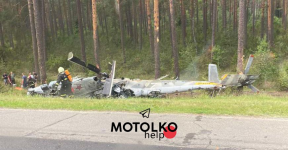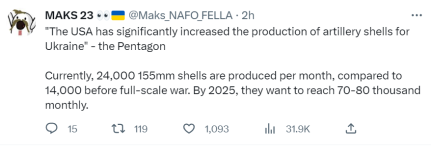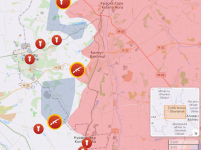Ukraine - Russia Conflict
- Thread starter randomradio
- Start date
You are using an out of date browser. It may not display this or other websites correctly.
You should upgrade or use an alternative browser.
You should upgrade or use an alternative browser.
Everything he wrote is pure BS, as usual. While F-16s would be more effective than their archaic Su-27/Mig-29, they won't be a match for Su-30SM2 and Su-35S.An excellent write up from Abhirup Sengupta (as usual) on the topics of F-16 for Ukraine. Raj should not read this it may cause harm to your delusional mind..... Btw Sengupta is of the Indian species so you can't disagree with him... or you're racist!
Q: How are a few dozen obsolete F-16s in Ukraine going to fight against hundreds of top 10 fighters like the Russian Su-35?
A:
It’s funny how those hundreds of top Russian Fighters have been unable to achieve Air Superiority against some 82-odd Ukrainian Fighter aircraft and 40 year old Soviet Air Defences with roughly 1/8th the SAM density of 1991 Iraq (430 vs. 3,679 SAMs).[1] Ukrainian S-300PS dates back to 1985; Buk-M1 1983, making them about just as old as Iraqi Air Defences in the Gulf War.
Right now Ukrainian Mig-29 & Su-27 are using HARMs in Pre-briefed (PB) mode where the missiles are programmed on the ground to fly over suspected Russian SAM sites in lofted trajectory, being completely reliant on the their own seeker to acquire a target (Russian radar). Both Mig-29 and Su-27 lack the necessary data buses to fully communicate with HARM (or Western munitions in general). The rudimentary integration only allow the missiles to be launched in flight with the targeting data being preloaded on the ground before.
The F-16s with ASQ-213 HARMs Targeting pod (HTS) can geo-locate Russian SAMs in-flight and pass on their GPS coordinates to HARMs before launch in real-time, so that merely turning off the radar won’t be nearly as effective. The F-16 with HTS also has the ability to choose a specific radar type. You can have the pilot designate say S-300 or S-400’s Search radar(s) over SHORADs (Buk-M2, Pantsir-S, Tor-M) depending on the mission. The advantage of able to shoot HARMs at specific threat radar(s) instead of a random one in PB mode can’t be overstated.
View attachment 28474
All of these make F-16s vastly more capable in SEAD than Mig-29 using the same missiles. Also, F-16s have access to a wide range of ECM pods from American to Israeli and even European, some of them like ELL-8251 (escort-jammer) with significant jamming capability. This combined with much greater Situational Awareness in cockpit allows the F-16 to operate at medium to high altitudes and suddenly you’ve the HARMs launched from F-16s having double the range (~100 km) than Mig-29 operating at low altitudes and only making a short climb before launch (~50 km). So you can have the F-16s conduct SEAD operations from further behind the front lines. The F-16 will also be used alongside decoys like MALD. Ukraine already started using MALD-B decoys last month [2] and with F-16 they can be more extensively deployed as well as controlled in-flight based on real time intelligence.
View attachment 28475
F-16 carrying a MALD-J during testing
MALD decoy is basically a long-endurance UAV able to mimic the radar signature and flight envelope of attacking aircraft. By acting as a bait they protect the strike package as well as stimulate the enemy Air Defences, making them go ‘active’ and thereby, visible to HTS on F-16 for example. Because the F-16 with HTS can actually track emitters in real-time unlike Ukrainian Mig-29 or Su-27, they can make far more effective use of MALD.
You don’t necessarily need brand new Block 70 F-16 for SEAD, even 30 year old Block 20 F-16A with Midlife upgrade (MLU) and HTS pods can have serious SEAD capability with HARMs. Ukrainian Mig-29 & Su-27 are barely scratching the surface with HARMs, with F-16 the threat to Russian Air Defences will be so severe that there will be instances where Ukrainian pilots merely announcing ‘Magnum’ (HARMs launch code) on radio will have Russian SAMs turning off their radars and leave the airspace vulnerable to F-16 strikes. Now, this is not to say that you’re going to see Ukrainian F-16s running massive SEAD campaign like Desert Storm, no. They simply don’t have the resources. Nor would you see Ukrainian F-16s quickly achieving Air Superiority over the front lines. The Russian SAM-density over most region is simply too high for a dozen or so F-16s Ukraine would be receiving and given the lack of external support, they can’t be running SEAD campaign as effectively as Western Airforces could.
Instead you’re going to have Ukrainian F-16s generate ‘gaps’ in Russian Air Defences over the front lines. You see, today the front lines stretches over 1,400 km from North to East and the South. Russia simply doesn't have the resources to reinforce the entire front with long-range SAMs. Last year we already saw Russia deploying S-300 from its second larges city, St. Petersburg to the front lines in Ukraine. Add Ukraine’s recent drone attacks in Moscow and Russian oil refineries, which are only going to increase over the next 6 months and you’re going to have a scenario where Russian Air Defences would be in high demand both inside Russia and in Ukraine.
View attachment 28476
The current front line in Ukraine spans to over 1,400 km from the North to South
With Ukrainian F-16s picking out Russian Air Defences near the front lines, Russia will be forced to make sacrifices on which areas it would reinforce. This would leave large gaps over the front lines vulnerable to Ukrainian Airforce and subsequently their Armed forces. It will be a long SEAD campaign spanning over several months, unlike anything we have seen before but over time Russian SAM density on the frontline will decrease dramatically.
The F-16s also have significant Air-Ground capability, especially with extended-range: JDAM-ER enabling stand-off attack from over 74 km. The F-16 can provide in-flight targeting data to JDAMs unlike Ukraine’s Su-24 or Mig-29 limited to merely launching them with the targeting data being preloaded on the ground before. The F-16s also have a number of modern Targeting pods like LITENING or Sniper ATP that gives the pilot ability to see near-visual imagery (in IR spectrum) of ground targets from significantly longer range. Here’s a footage of Sniper ATP tracking a car from over 60 km while geo-locating its position in real time.
View attachment 28477
Sniper ATP footage. Left: Wide angle; Right: Magnified view.
Such long-range detection and targeting capability would allow Ukrainian F-16s to locate and target Russian forces especially mobile targets across the front line, something both UAF and VKS have been struggling to do lately. The F-16s will also be able to use GBU-39 SDBs that have a 110 km range with a 93 kg penetrating warhead which is about the same as GMLRS that Ukraine has been extensively using since last year. You can have the F-16 carry 8 SDBs quadpacked on two pylons, far exceeding the firepower of a M142 HIMARS (6 GMLRS). And the F-16 can do so while carrying 2 HARMs and 4 AIM-120s on the rest 4 pylons and wingtip launchers allowing it to combine SEAD with strike missions. This is the kind of flexibility F-16s bring to the table and one of its advantage over others like Gripen-C, having about 50% greater weapons payload in real world.
The F-16’s strike capability isn’t limited to PGMs but also in long range strikes with weapons like JSOW-C and Harpoon AShMs. Ukrainian uncrewed surface vessels (USV) have already been creating serious nuisance for Russia’s Black Sea fleet based in Sevastopol, Crimea. Having seriously damaging a number of Russian ships and occasionally harassing them in the Black Sea. The F-16s significantly changes the calculus as Ukraine can put their existing Harpoon AShMs on F-16 and use the increased range to strike Russian ships in Sevastopol and the Black Sea with actual AShMs instead of a slow tug boat loaded with explosives.
View attachment 28478
A ROCAF F-16 with two AGM-84 Harpoon AShMs
If Ukraine were to ever take back Crimea then it needs to remove the viability of Russia using Sevastopol as a warm water port in Black Sea and there’s nothing better than F-16s to do that. Living under the constant threat of an AShM attack from Ukrainian F-16 and loosing a few ships in the process significantly reduces the militarily value of Crimea. Sooner or later Russia will be forced to remove its fleet from Sevastopol. The F-16s will also open the possibility of Ukraine receiving AGM-84 SLAM-ER that are based on Harpoons. The SLAM-ER have similar range as the Storm Shadow (270 km) Ukraine started using lately, but are relatively cheaper and more widely available which will likely result in Ukraine receiving them in greater numbers. Together with Storm Shadow it will be used to attack Russian bases in Crimea and given last year’s attack on Saki airbase that destroyed more than 12 Russian aircraft on the ground, we know just how well Russian Air Defences would fare against them.
Air-Air
The first batch of F-16s Ukraine is likely to receive will be from Denmark, Netherlands and other European operators. They’re Block 20 F-16AM having undergone MLU with modest radar upgrade, addition of JHMCS (Helmet Mounted Cueing System), larger multifunctional colour display in cockpit in addition to other software and hardware upgrades to facilitate integration of more capable pods (HTS R7) and modern weapons (AGM-88D/E, AIM-120C/D, JSOW-C, JASSM, SDB, etc). They carry older APG-66v2 Mechanical radars with modest upgrades (new processors to increase computing power) expanding the ability to engage 6 targets with AIM-120 which is quite significant considering their age and actually more than N011M on Su-30 (4 targets).[3] While it should be able to take advantage of AIM-120C5, it’s unlikely to fully exploit the envelope of AIM-120C7. Although given the threat environment in Ukraine it’s highly likely that sooner or later Ukrainian F-16 will be retrofitted with APG-68(v)9 radars from 2004 designed for Block 50/52+ F-16. The APG-68v9 is a Mechanical radar as well but with greater range and better Air-Ground modes (0.6 m SAR maps), enabling the F-16 to better exploit AIM-120C7’s envelope.
The AMRAAM will give Ukraine a massive boost in capability. Consider that Ukrainian Mig-29 & Su-27 have been flying with R-27 having semi-active radar homing (SARH) requiring the launch platform to keep ‘painting’ the target until the very end which puts them at a huge disadvantage against Russian aircraft using R-77 with active guidance and the ability to disengage after missile launch.
The AIM-120 is also significantly more capable than R-77, not just in terms of being more resilient to jamming (AMRAAMs have been consistently upgraded throughout its service life with 7 major upgrades since introduction while R-77 had just one) but also in terms of range. While the actual envelope of any AIM-120 remain classified, even Russian estimates show the older AIM-120A/B having at least 30% greater range than R-77.
View attachment 28479
Russian estimate of AIM-120A/B (Lines) and R-77 envelope (Coloured region inside). Overlap credit: Garrya
The AIM-120C5 had almost twice the range of AIM-120B (105 vs. 55 km) whereas the R-77–1 only had a modest 37% increase over its predecessor (110 vs. 80 km). As a side note their ranges are apples to orange as evident from the chart above – the AIM-120A/B can achieve its 55 km range at 32,000 ft. whereas the R-77 can only achieve its 80 km range above 50,000 ft.
Also, Russian aircraft aren't just handicapped by shorter range of R-77 but also their fire control radars. While Irbis-E having 350 km range against a 3 m^2 in cued-search sounds impressive in first glance, what many don't realise is that Irbis-E has a maximum engagement range of 250 km even against a B-52 Bomber, similar to how Its predecessor N011M Bars on Su-30 had a 200 km maximum targeting range.
View attachment 28480
KNAAPO’s Su-35 brochure
Irbis-E isn't going to track a Fighter-sized aircraft beyond 100–120 km, something also evident from its flight test video where it tracks a target from less than <100 km despite having detected the same target from 268 km.[4] This is because Russian manufacturers love to market ranges in Velocity Search mode unlike Western manufacturers publishing Track While Scan (TWS) figures. Thailand’s joint exercise with PLAAF involving Gripen-C and J-11 in 2015 Falcon Strike highlighted just how far behind Russian aircraft lag in BVR combat. Take a look at the number of kills scored by both sides at 50 km, 30 km and visual-range.
View attachment 28481
Number of kills at respective ranges by Gripen-C/D (Blue) and J-11 (Red)
You can see how Gripen-C with AIM-120 completely dominated the BVR spectrum against J-11 (Su-27), with the latter only having an advantage in WVR engagements because of HOBS missile (R-73) as Thailand was using the older AIM-9M on their Gripen. Part of this is because of AMRAAM’s superior envelope and part of it due to Russian radars significantly lagging behind Western counterparts. Notice the disproportionate ratio of kills even at 30 km. Granted the Su-30 and Su-35 carry more capable radars today but so would Ukrainian F-16AM.
How well Ukrainian F-16s will be able to handle Russian aircraft will ultimately depend on what radar they will be having and the AIM-120C variant supplied. Over the year we’ve seen US being bit more relaxed in terms of sending advanced weaponry to Ukraine and there are very good reasons to retrofit Ukrainian F-16s with more capable sensors (radar, HTS pod, etc.) given the serious SAM threat they would be facing, never mind the aerial threat. Even in worst case scenario these “obsolete” F-16AM will have roughly comparable air-air capability as the latest Russian Fighters and that completely changes things for the VKS.
-------------------------
It’s worth mentioning that you’re not going to see Ukrainian F-16s directly confronting Russian Airforce, they simply won’t have the numbers. Instead we’re more likely to see ambushes aimed at disrupting Russian aircraft’s stand-off attack near the front lines as well as their combat air patrols near Ukrainian border, especially around Black Sea (where you’ve little Russian SAM coverage). Mig-31BM is one of the only Russian aircraft that pose a serious threat to Ukrainian F-16 because of their ability to launch R-37M from significantly long-ranges. Individually R-37M will have poor pK against manoeuvrable targets but when used routinely to attack enemy Fighters, the risk increases quite dramatically.
Although it’s also worth remembering that Ukraine have been spending a lot of efforts in forward deploying some of the Western Air Defences near the front line. We already saw Ukrainian SAMs threatening Russian aircraft some 50 km inside Russian border when VKS lost a Su-35, Su-34 and 2 Mi-8 helicopters on a single day in Bryansk Oblast, north of Ukrainian border (May 13, 2023). As the airspace near the frontline becomes increasingly contested, you won’t have the Mig-31 able to engage Ukrainian aircraft as easily as they’ve been able to so far.
The F-16 is going to have a huge impact in this conflict, perhaps more so than just about anything else. The capabilities it brings to the table, not just as a platform but also the ability to employ a large arsenal of very capable weapons far exceeds anything that’s available to Ukraine. Most people fail to understand what Air power brings to the table, especially when they’ve spent a year watching two opposing Airforces fight with horribly outdated equipment and weaponry. The F-16s isn’t a joke that Russian fanboys make it out to be. There’s a reason Russia resorted to extreme measures to prevent the transfer of advanced weapon system to Ukraine, in particular Western Fighter aircraft. Unlike the trolls Russian military leaders understand the consequences of Ukraine operating F-16.
Since the Russian invasion what Ukrainian Airforce have been able to do with its small and seriously outdated Russian fleet is nothing short of remarkable. They’ve been remarkably patient and persistent in their efforts despite overwhelming odds. Having looked at their performance over the year, I can only imagine what they’d do with their future F-16 fleet. As an aviation enthusiast it’ll be really interesting to see how things unfold at the end of this year and beyond.
I told you not to read this, Raj! How are you holding up?
Get ready to get your F-16s blown by Russian flankers just like Kornets are blowing your Bradleys and Leopards. Just send your jets and see for yourself.
Russia is saying these are the consequences of the strike on the bridge. Why are they so damn bad at lying? It's not like they lack practice.

AIM 9M and R 73 belong to the same generation of missiles, R 73 advantage may be due to the complex rudder surface, the off-axis angle greater than 10 °You can see how Gripen-C with AIM-120 completely dominated the BVR spectrum against J-11 (Su-27), with the latter only having an advantage in WVR engagements because of HOBS missile (R-73) as Thailand was using the older AIM-9M on their Gripen. Part of this is because of AMRAAM’s superior envelope and part of it due to Russian radars significantly lagging behind Western counterparts. Notice the disproportionate ratio of kills even at 30 km. Granted the Su-30 and Su-35 carry more capable radars today but so would Ukrainian F-16AM.
WVR can appear such a big gap, pure Chinese Air Force have better training.
The N 001M radar used by the Su 27 is 1970s technology.but radar used by Gripen is a 1990s technology, like the current gap between AESA and PESA, The F 16AM radar is APG 68 radar, and N 011M radar performance is similar, not as good as N 035 radar performance
Last edited:
. Btw Sengupta is of the Indian species so you can't disagree with him... or you're racist!

BTW, Nice Write-Up.
I Expected better reply from you. Pls, Give More Specific rebuttal. Point by point.Everything he wrote is pure BS, as usual. While F-16s would be more effective than their archaic Su-27/Mig-29, they won't be a match for Su-30SM2 and Su-35S.
Get ready to get your F-16s blown by Russian flankers just like Kornets are blowing your Bradleys and Leopards. Just send your jets and see for yourself.
Abhirup Sengupta is a knowledgeable person, no doubt! But he is a US shrill and is too biased for any US defence equipment. He argues that Russia doesn't enjoy Air Superiority over Ukraine, which is pure BS.
BTW, Nice Write-Up.
I Expected better reply from you. Pls, Give More Specific rebuttal. Point by point.
Just read this and then the whole article to know how much fear Su-35S with its R-77-1/R-37M combo has caused among Ukrainian fighter pilots:
One of the main issues Kyiv’s ground forces have faced as the counteroffensive gets underway is Russian air power holding them back. Russia still maintains air superiority, which makes it difficult for ground forces to advance.
This is directly from CNN and not RT Times or Sputnik. Check this link and read this whole article:
Sweetie is just trolling, there's no point in refuting his err..Abhirup's biased arguments, lol.
You won't make that mistake again.I Expected better reply from you.
Depends how you define 'air superiority'. Certainly 3 helicopters downed in 1 week doesn't fit my description. A 4th also downed itself in Belarus today. What they have is a marginal advantage because the enemy is coming their way into defended territory. They still can't fly freely inside Ukrainian airspace and have to use expenssive stand-off weapons to attack targets <100km (Kryvyi Rih) from the front line. That ain't air superiority by the NATO dictionary. What they have is air parity, with a marginally favourable air situation around the front line due to enemy advance.Abhirup Sengupta is a knowledgeable person, no doubt! But he is a US shrill and is too biased for any US defence equipment. He argues that Russia doesn't enjoy Air Superiority over Ukraine, which is pure BS.
Just read this and then the whole article to know how much fear Su-35S with its R-77-1/R-37M combo has caused among Ukrainian fighter pilots:
This is directly from CNN and not RT Times or Sputnik. Check this link and read this whole article:
Sweetie is just trolling, there's no point in refuting his err..Abhirup's biased arguments, lol.
Fine, good week so far and the weather has improved.What's up my dear friend? How are you ?
This allegedly shows the shootdown of a Storm Shadow requiring 2 missiles. Very bad discontinuity at alleged impact point and worse graphics than a ZX Spectrum.








